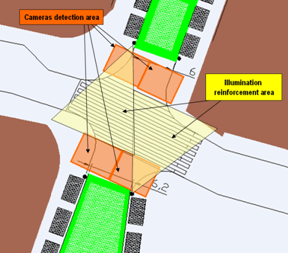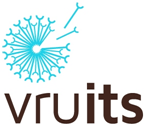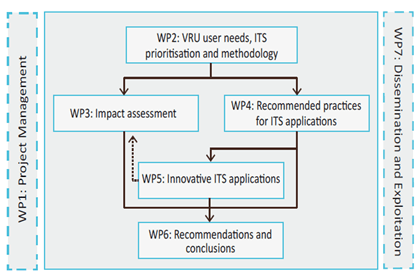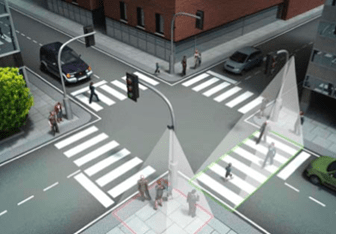VRUITS (Improving the Safety and Mobility of Vulnerable Road Users through ITS Applications) is a Research project co-funded by the European Commission under the Seventh Framework Program (Grant Agreement Nº MOVE/FP7321586/VRUITS). It started in April 2013 and its final tasks are scheduled for March 2016. The Project VRUITS investigates how the safety, mobility and comfort of pedestrians, cyclists, Powered-Two-Wheelers and elderly drivers can be improved whit ITS applications. The research includes the improvement of the usability of different applications and the integration of VRUs in cooperative traffic systems.
Objectives of VRUITS project are:
- Assess societal impacts of ITS applications and provide recommendations for policies and industry on their usage, in order to improve the safety, mobility and comfort of VRUs;
- Recommend practices on how Vulnerable Road Users can be integrated in Intelligent Transport Systems and on how HMI designs can be adapted to meet the needs of VRUs, on the basis of evidences and through field trials.
The project consists of two vertical work packages: WP1 and WP7, and five horizontal work packages (WP 2-6) as shown in the figure.
First, an overview of existing and upcoming ITS systems for VRUs was provided. A total of 14 systems addressing pedestrians, 34 addressing cyclists, 28 for PTWs, and a number of 10 in-vehicle systems which benefit all kind of VRUs were initially picked. In order to identify the most promising solutions, a workshop was held with 40 relevant stakeholders including representatives of VRU groups, national and European authorities, infrastructure service providers and ITS-related organizations contributed to the prioritization process. Participants selected up to 22 applications having the highest potential for VRUs safety and rated these ITS solutions according to a set of criteria previously decided by VRUITS partners.
Activities in the next step addressed the adaptation of impact assessment methodology, in order to carry out qualitative and quantitative assessment of ITS for sub-groups of VRUs with regards to the aspects of safety, mobility and comfort, and to translate these into socioeconomic indicators. Moreover, user-acceptance and usability of existing ITS services for VRUs have been assessed, focusing on comfort, mobility and effectiveness of related information. A second workshop with stakeholders was held for this topic.
Thanks to the expertise of the participants, from the huge group of ITS initially assessed, 10 applications were withheld. The Consortium selected two of them to be demonstrated in Spain (Valladolid and Alcalá de Henares) and the Netherlands (Helmond): a cooperative Intersection Safety (INS) for cyclists in Helmond (Netherlands), an Intelligent Pedestrian Traffic Signal (IPTS) in Valladolid (Spain) and cooperative IPTS & a cooperative INS for drivers in Alcalá de Henares (Spain).
Equipment and applications at the test sites have been adapted and developed following the prioritization of ITS for VRUS and the recommended practices performed beforehand, in order to be suitable for testing by real users and under real environment.
- Valladolid site is based on the Intelligent Pedestrian Traffic Signal (IPTS) system: several Intelligent Pedestrian Detectors (IPDs) automatically detect pedestrians on the sidewalk next to the crossing, and based on their trajectories, IPDs decide whether pedestrians are waiting to cross the intersection. The IPDs send this information to an Interface Box, which gathers the data from all the IPDs and requests green light to the Traffic Light Controller (TLC) if there is a certain number of persons waiting. Then the TLC decides whether to give priority to pedestrians over vehicles and extend their green phase, based on the state of the traffic lights. This pilot also includes an Illumination on Demand Module (IDM), which is used to highlight the crossing and its surroundings, informing vehicles about the presence of pedestrians and thus enhancing the safety of the pedestrians. The objective of IPTS is to increase safety and comfort for pedestrians by automatically detecting them, extending their green phase and increasing illumination on the crossing. This application is mainly intended for areas with large amount of pedestrians.

- Alcalá de Henares site implements a smart traffic controller, which is based on the main characteristics of the Intelligent Pedestrian Traffic Signal (IPTS) and the Intersection Safety (INS) systems. The IPTS includes VRU2I (VRU-to-Infrastructure) and I2VRU (Infrastructure-to-VRU) communications where pedestrians can activate green light demand for crossing an intersection via their smart phone and in response to this, the traffic light controller (TLC) provides them the time remaining to activate pedestrian green light. While VRUs are crossing the IPTS detects them to extend the pedestrian green phase, ensuring their safe crossing. The INS includes I2V (Infrastructure-to-Vehicle) communications to inform drivers turning right, with low visibility, about pedestrians’ presence on the road. The detection of pedestrians on the crosswalk, made by the IPTS, is used to give this information to drivers. A drivers’ mobile application connected to a prototype device, able to communicate to the smart traffic controller, is developed for this function. The objectives of IPTS are increasing safety and comfort for pedestrians, (by allowing VRUs to activate a remote demand for green light and extending time on pedestrian green phase for safety crossing) and preventing collisions between right-turning vehicles with low/no visibility and crossing VRUs (by detecting the pedestrian crossing and warning the driver of the existing pedestrian crossing and iIncreasing the illumination at the pedestrian crossing).
At the end of September (date to be confirmed) a dissemination workshop targeted to local authorities and ITS industry will be held at CIDAUT premises. During this workshop, trial tests performed in both Spanish locations (Valladolid and Alcalá de Henares) will be presented, as well as an assessment on the results obtained.



